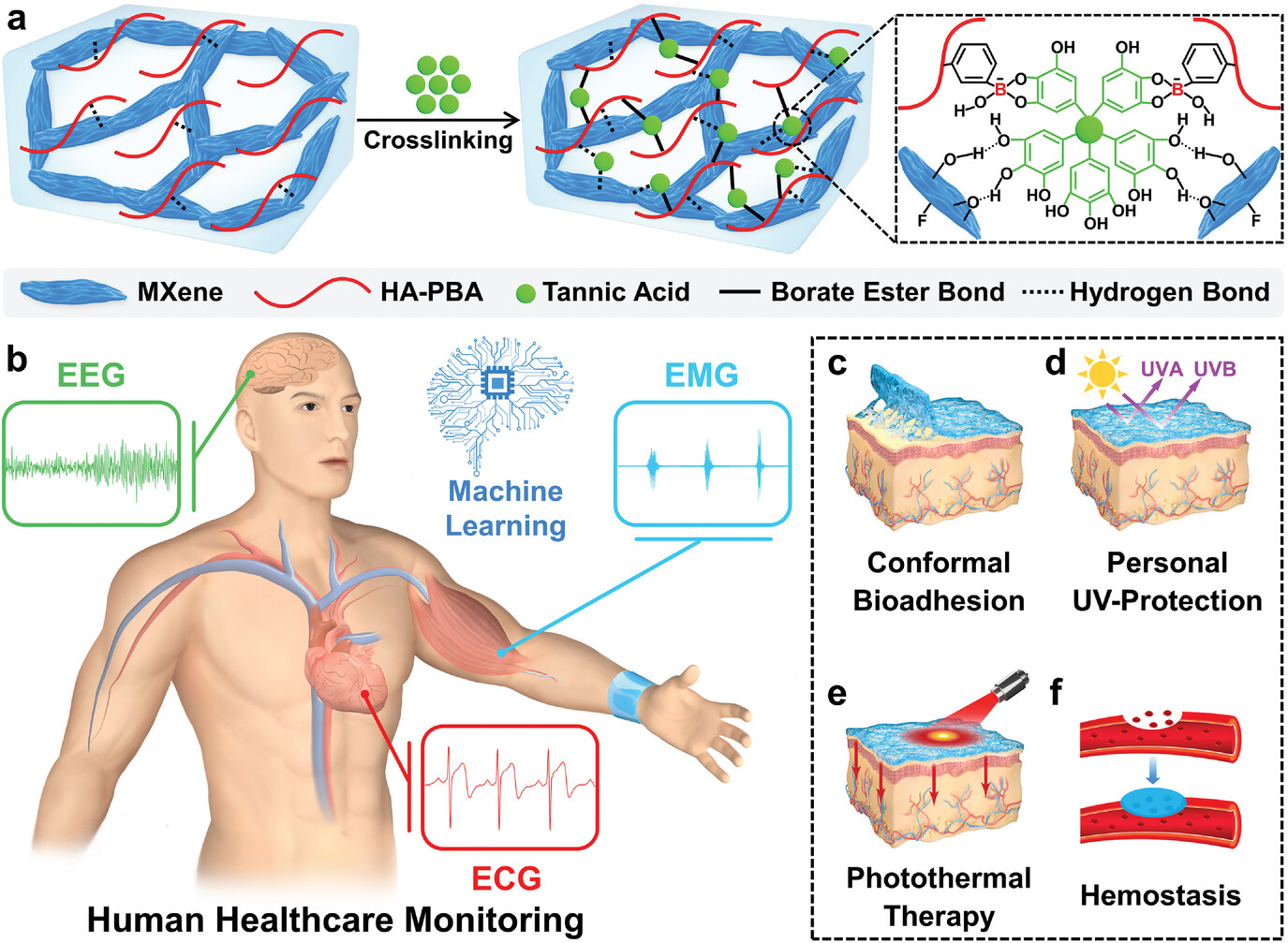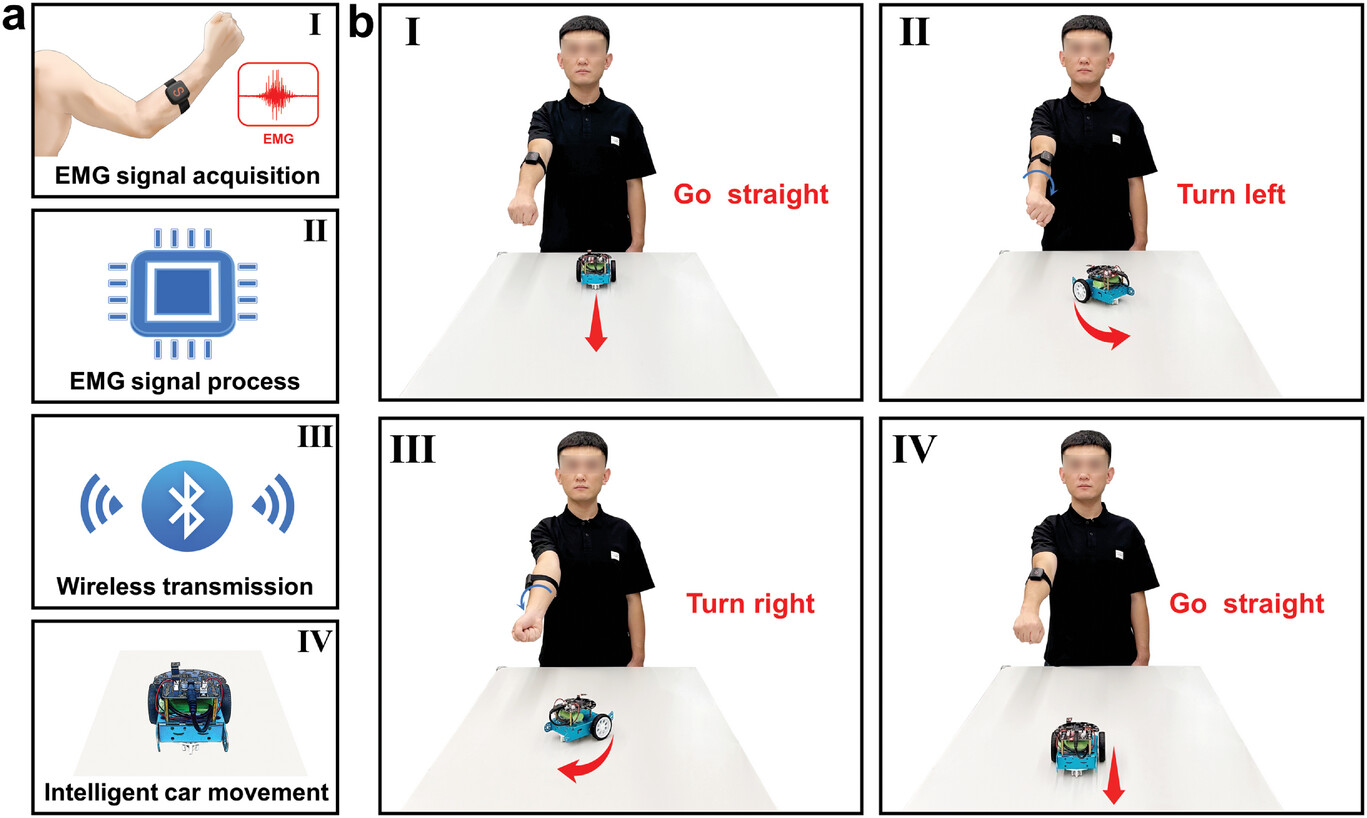| May 20, 2024 | |
Innovative MXene hydrogel enables wearable health monitoring and treatment |
|
| (Nanowerk Spotlight) Imagine a future where a simple stick-on patch can continuously monitor your vital signs, alert you to potential health issues, and even deliver targeted therapies – all while you go about your daily life. This vision of seamlessly integrated, multifunctional wearable health devices has driven decades of research, with scientists striving to create ever more sophisticated and capable technologies. | |
| However, the path to this futuristic ideal has been fraught with challenges. Materials that are comfortable and durable enough for long-term wear often lack the necessary electrical properties for sensitive monitoring. Adhesive patches that can maintain robust skin contact frequently struggle with biocompatibility and signal fidelity. | |
| The sheer complexity of integrating multiple functions – from real-time biosensing to therapeutic delivery – into a single, wearable platform has proven a formidable obstacle. | |
| In recent years, progress in fields such as flexible electronics, nanomaterials, and biocompatible polymers have paved the way for novel approaches to wearable device design. Two-dimensional nanomaterials like graphene have shown particular promise due to their excellent electrical conductivity, high surface area, and mechanical strength. Concurrently, innovations in hydrogel engineering have yielded materials with improved adhesion, self-healing properties, and capacity to interface with biological systems. | |
| By innovatively combining the unique properties of a cutting-edge nanomaterial called MXene with a specially engineered polymeric hydrogel, researchers have developed a multifunctional "smart skin" that could revolutionize wearable health technology. | |
| This novel material, described in a recent paper published in Advanced Materials ("Flexible Conformally Bioadhesive MXene Hydrogel Electronics for Machine Learning-Facilitated Human-Interactive Sensing"), demonstrates an unprecedented range of capabilities – from sensitive health monitoring to UV protection to on-demand photothermal therapy – all integrated into a single, flexible, skin-attachable device. | |
 |
|
| a Schematic illustration of the preparation of the adhesive, healable, and antibacterial MXene/HA-PBA/TA hydrogel and the further promising applications in b human healthcare monitoring, c) conformal bioadhesion, d personal UV-protection, e photothermal therapy (PTT), and f wound hemostasis. (Reprinted with permission by Wiley-VCH Verlag) | |
| MXenes are a class of two-dimensional inorganic compounds with high conductivity, hydrophilicity, and biocompatibility that make them promising for wearable devices. The research team dispersed MXene nanosheets into a hydrogel composed of hyaluronic acid grafted with phenylboronic acid (HA-PBA) and tannic acid (TA). This combination leveraged the adhesive properties of TA and the self-healing dynamic bonds between HA-PBA and TA to create a stretchable, skin-attachable matrix to host the MXene nanosheet network. | |
| The resulting MXene/HA-PBA/TA hydrogel demonstrated remarkable properties. Its flexibility and low modulus allowed it to establish seamless contact with the skin, maintaining adhesion even under strain. This robust interface ensured reliable signal transmission with notably improved signal-to-noise ratios – for example, 35.63 dB for EMG signals compared to 4.75 dB for commercial electrodes. The incorporated MXene nanosheets endowed the hydrogel with excellent electrical conductivity, addressing a common limitation of hydrogel-based devices. | |
| When assembled into epidermic sensors, the MXene/HA-PBA/TA hydrogel could accurately detect a wide array of physiological signals, including human motions, arterial pulses, and even subtle eye movements. Notably, it reliably recorded high-fidelity electrocardiogram (ECG), electromyogram (EMG), and electroencephalogram (EEG) signals, demonstrating its potential for advanced health monitoring. | |
| The hydrogel also exhibits multifunctional smart capabilities. The tannic acid provides a UV-absorbing effect, as demonstrated by its ability to protect mouse skin from UV-induced damage in experimental studies. It shows intrinsic antibacterial activity, with an 89.61% efficiency against E. coli and 93.15% against S. aureus, which could help maintain hygiene during extended wear. | |
| The MXene nanosheets allow the hydrogel to provide targeted photothermal therapy. Upon near-infrared irradiation at 0.75 W cm-2, the hydrogel achieved a rapid localized heating effect, reaching an equilibrium temperature within ≈150 seconds. This photothermal effect could potentially be used to soothe sore muscles, promote circulation, or treat conditions like arthritis, though further studies are needed to validate its therapeutic efficacy. | |
| The researchers even demonstrated the hydrogel's potential for human-computer interaction by using its EMG signals to train a machine learning algorithm for sign language recognition with over 98% accuracy. | |
 |
|
| Promising application of the intelligent wireless car movement control based on electromyogram (EMG) signals. a) Schematic illustration of a synchronous intelligent wireless car control system on collected EMG signals. b) The real-time control of the intelligent wireless car movement by the MXene/HA-PBA/TA sensor-integrated armband attached on the arm of the volunteer: (I) the intelligent car starts and goes straight, (II) the intelligent car turns left, and (III) turns right, and (IV) the intelligent car goes straight. (Reprinted with permission by Wiley-VCH Verlag) | |
| While these findings are promising, it's important to note that further work is needed to comprehensively validate the long-term safety, efficacy, and durability of this technology. The researchers acknowledge the need for more in-depth studies and refinement before clinical translation. | |
| Nonetheless, this MXene/HA-PBA/TA hydrogel represents an exciting advancement in wearable health monitoring devices. By pushing the boundaries of materials science to create a biocompatible, multifunctional smart skin, the researchers have opened up new possibilities for integrated health monitoring and therapy delivery. Though challenges remain, this innovative confluence of nanomaterials, biomaterials, and electronics brings us closer to a future where wearable devices are seamlessly integrated into our health and lives. | |
 By
Michael
Berger
– Michael is author of three books by the Royal Society of Chemistry:
Nano-Society: Pushing the Boundaries of Technology,
Nanotechnology: The Future is Tiny, and
Nanoengineering: The Skills and Tools Making Technology Invisible
Copyright ©
Nanowerk LLC
By
Michael
Berger
– Michael is author of three books by the Royal Society of Chemistry:
Nano-Society: Pushing the Boundaries of Technology,
Nanotechnology: The Future is Tiny, and
Nanoengineering: The Skills and Tools Making Technology Invisible
Copyright ©
Nanowerk LLC
|
|
|
Become a Spotlight guest author! Join our large and growing group of guest contributors. Have you just published a scientific paper or have other exciting developments to share with the nanotechnology community? Here is how to publish on nanowerk.com. |
|
